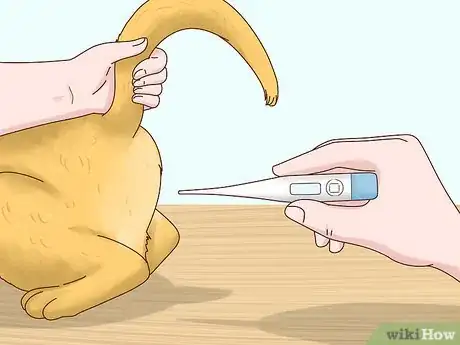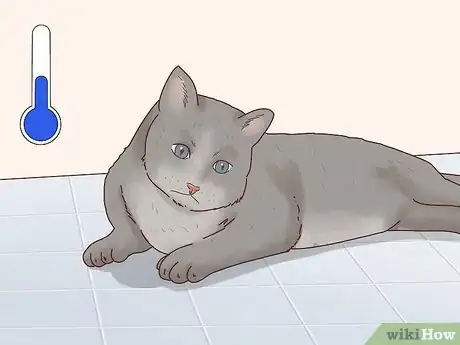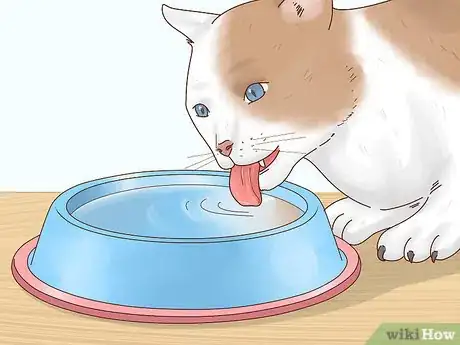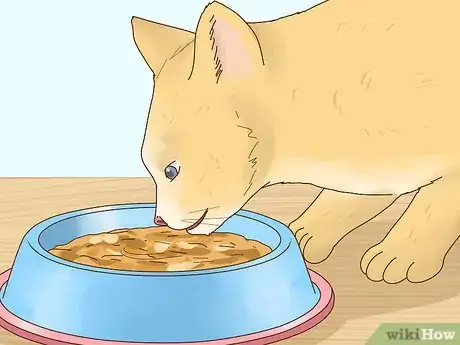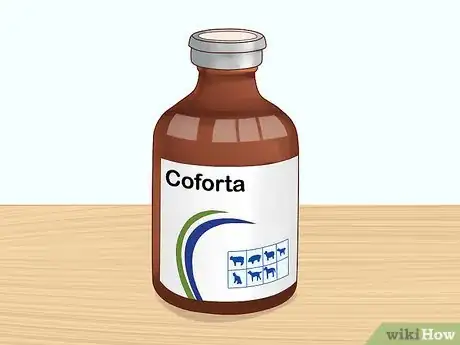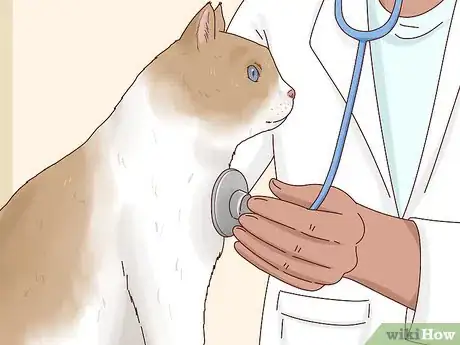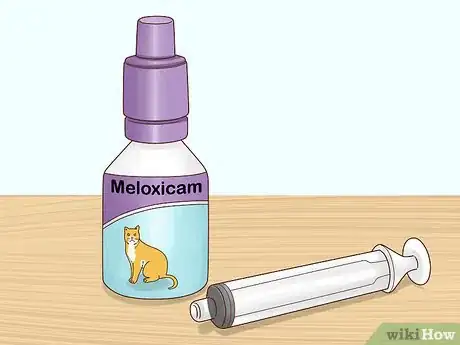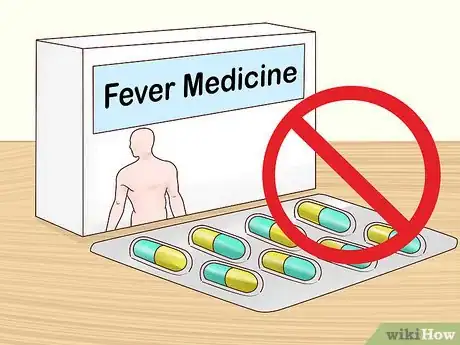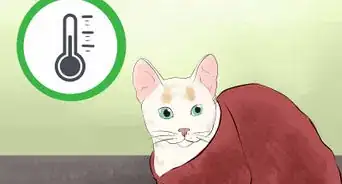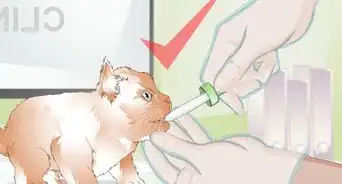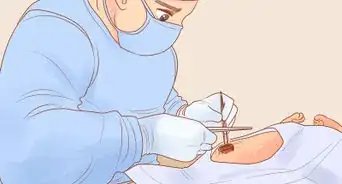This article was co-authored by Brian Bourquin, DVM. Brian Bourquin, better known as “Dr. B” to his clients, is a Veterinarian and the Owner of Boston Veterinary Clinic, a pet health care and veterinary clinic with three locations, South End/Bay Village, the Seaport, and Brookline, Massachusetts. Boston Veterinary Clinic specializes in primary veterinary care, including wellness and preventative care, sick and emergency care, soft-tissue surgery, dentistry. The clinic also provides specialty services in behavior, nutrition, and alternative pain management therapies using acupuncture, and therapeutic laser treatments. Boston Veterinary Clinic is an AAHA (American Animal Hospital Association) accredited hospital and Boston’s first Fear Free Certified Clinic. Brian has over 19 years of veterinary experience and earned his Doctor of Veterinary Medicine from Cornell University.
There are 26 references cited in this article, which can be found at the bottom of the page.
wikiHow marks an article as reader-approved once it receives enough positive feedback. This article received 19 testimonials and 88% of readers who voted found it helpful, earning it our reader-approved status.
This article has been viewed 619,496 times.
Whether it’s you or your cat, having a fever isn’t necessarily a bad thing. It’s a normal immune response that helps the body recover from illness by killing heat-sensitive bacteria. The heat from a fever also increases blood flow to injured tissues to help repair them; however, there are instances in which fever is dangerous. If your cat is sick with fever, you can help reduce it so she has a quicker recovery. There are also plenty of medications you can consider. Making your cat more comfortable will help her get over her fever and back to normal.
Steps
Reducing Fever at Home
-
1Recognize the symptoms of fever in cats. The normal range of rectal temperature for cats is from 38.1 C to 39.1 C (100 to 102.5°F).[1] If you can't easily take your cat's temperature, the following symptoms could indicate a fever:[2]
- Poor appetite
- Lethargy
- Inactivity
- Weakness
- Excessive shedding
- Withdrawing away from other cats[3]
- Rapid or shallow breathing
- Shivering
- Decreased grooming activities
- Because most fevers are caused by an underlying condition, be on the alert for other symptoms such as vomiting, diarrhea, coughing, sneezing or skin swellings. These could point to a reason for your cat’s illness.
- Your cat may not have any signs of a fever, so take them to a vet if you suspect they have one.[4]
-
2Take your cat’s temperature. Symptoms are a good sign that your cat has a fever, but the only way to know for sure is to take her temperature with a thermometer. You can take your cat’s temperature rectally or in its ear.[5]
- Gather your supplies. You will need a thermometer, lubricant (e.g., petroleum jelly or K-Y), alcohol and paper towels, and a cat treat.
- If using a glass thermometer, shake it until the mercury is below the 96F (35C) line. Simply switch on a digital thermometer. Use a special thermometer designed for pets to measure temperature in the ear.
- If measuring your cat’s temperature rectally, lubricate the thermometer.
- Cradle your cat under one arm, or ask someone else to hold her. Raise her tail.
- Insert the thermometer into your cat’s anus about one inch. Hold a glass thermometer in place for 2 minutes. Remove a digital thermometer when it beeps.
- Clean the thermometer with rubbing alcohol and paper towels.
- Give your cat a treat to comfort her.
- If your cat’s fever is over 102F (39C), take her to see a vet immediately. High fevers can cause organ damage.[6]
- Take your cat to the vet if you have trouble taking its temperature on your own.[7]
Advertisement -
3Examine your cat’s body. Gently press your cat’s body with your fingers.[8] Determine whether you can feel any injuries like bone fracture, swollen lymph nodes, abscess, wound infection or tumors. All of these instances can cause fever.[9]
- You may or may not be able to feel a bone fracture in your cat. Fractures or breaks in bones can cause swelling or bruising in the break area. If you apply pressure to the injured area your cat will respond with pain. Be gentle as you examine your cat.[10]
- You should be able to feel swollen lymph nodes under your cat’s jaw area and around her shoulders. Swelling at the back of the legs or near the groin is also possible.[11]
- Immediately take your cat to the vet if you notice any of these symptoms. These conditions require prompt medical attention.
- If you do not notice any of these symptoms, the fever is likely a normal immune response. If possible get your cat examined by a vet who will try to identify the source of the infection. Follow the steps below as directed unless your cat's fever has been present for over 24 hours.
- If your cat has had a fever for more than 24 hours, seek veterinary advice and treatment as soon as possible.
-
4Help your cat cool down. Cats lose heat through sweat glands in their paws and by panting. Help your feverish cat cool off so you can reduce her body temperature. Find a cool, dark, room, preferably with a slate or tile floor so that she can stretch out and transfer her body heat to the tiles. You can also try these ways to help your cat cool off:[12]
- Position a fan on the floor so that it blows cool air over her body.
- If your cat will tolerate it, gently wet her coat with water. You can use a damp cloth or a spray bottle to dampen her coat. The evaporation will help to cool her body.
-
5Provide plenty of water. Fever can be caused by dehydration, and can also cause dehydration.[13] It is important that you provide fresh water at all times to your cat. If your cat is having trouble drinking, provide your cat with water via syringe (without a needle).[14] Rehydrating your cat can reduce fever (this is the reason why cats are given IV fluids at the vet’s clinic).[15]
- A feverish cat will not want to get up and walk about, so make sure she has drinking water within reach. You can sponge her gums with tepid water.
- In addition to water, you can also give Gatorade or children’s electrolyte solutions to cats with fever. These may help restore your cat’s electrolyte balance, especially if she has been vomiting or had diarrhea.[16] [17] You can use a syringe to get your cat to drink Gatorade.
- If your cat is resistant to syringe hydration, try freezing some water or Gatorade into cubes. Your cat may be more interested in licking an ice cube than drinking (and the cold will help her cool down).
- Never give your cat milk! Cats are very sensitive to lactose. Milk can make your cat ill and cause nausea, vomiting, or diarrhea.[18]
-
6Make sure she’s eating. Fever requires huge amounts of energy and can leave your cat very weak. Your cat may not feel up to eating solid food. You can supplement her diet by providing soft foods. Soft scrambled eggs[19] or canned tuna run through a food processor[20] can be good options.
- If your cat refuses solid or soft food, try using a syringe to feed your cat milk replacer (sold at pet stores). This is a food that’s designed for feeding sick cats or nursing motherless kittens. Use a syringe (no needle) with 5cc to 10 cc capacity.
- Insert the tip of the syringe on the insides of corners of the mouth, closest to the cheek. Cats and dogs will swallow by reflex anything that has passed in this area inside the mouth.
- If your cat cannot eat, ask your vet about high-calorie liquid supplements. Your cat can consume these until she is well enough to eat solid food again.[21]
-
7Give your cat vitamin B and energy supplements. It’s a good idea to ensure your cat’s nutrition by boosting her appetite. Vitamin B-complex and energy supplements added to her diet can accomplish this.[22]
- A vitamin and energy supplement like Nutri-Plus Gel (at 5ml daily for 5 days) can be given to battle fatigue and a lack of nutrients.
- An example of a very good B-complex vitamin is Coforta. It has a high concentration of cyanocoblamin (3), which is needed in energy metabolism. It is injected at 0.5ml to 2.5 ml per cat once a day for 5 days Subcutaneously (SQ) or Intramuscularly (IM):
- For small cats less than or equal to 1 kg (2.2 lb), 0.5 ml
- For cats 2 to 6 kg (4.4 to 13.2 lb), 1 ml
- For large cats, 7 to 9 kg (15.4 to 19.8 lb), 2.5 ml
- For cats between these weight ranges, estimate a dose between these or follow vet advice, erring toward a lower dose.
- Never give your cat supplements with the following ingredients. They can be toxic to cats:[23]
- Garlic or onion
- Calcium
- Vitamin D
- Vitamin C
Reducing Fever through Medication
-
1Take your cat to the vet. If your cat seemed well but was running a fever, after 24 hours take her to the vet. If she was off-color and running a fever, don't wait that long. Extended high-grade fevers can be a sign of more serious health issues. Your vet can perform examinations and tests to help determine the cause of the fever.[24]
- Be sure to tell your vet your cat’s recent history. Information to provide could include travel history, contact with other animals, recent vaccinations or other treatments, allergies, and anything else that you believe may be the cause of your cat’s fever.[25]
- A fever can happen for a number of reasons, including:[26]
- Bacterial, viral, or fungal infections
- Physical trauma
- Auto-immune disease
- Necrotic tissue
- Tumors or cancers
- The cause of the fever will determine the treatment. Your veterinarian will need to perform tests to determine the cause of your cat’s fever. Common tests include bloodwork and urinalysis.[27]
-
2Use antibiotics if vet-recommended. If your cat’s fever is caused by a bacterial infection, the underlying infection must be treated. Usually giving antibiotics would be enough to reduce a fever. While antibiotics are generally safe for a cat with a fever, do not self medicate. Always ensure that the vet has checked and prescribed antibiotics for your cat. Antibiotics are often specific to one strain of bacteria and may not be effective for others. Your vet can recommend the best treatment for your cat.[28] The most common and safe antibiotics usually prescribed by vets are:[29]
- Ampicillin and Amoxicillin (20mg/kg body weight). Both are available in suspension form and can be bought in "human" pharmacies.
- Marbofloxacin (2 mg/kg) is available in tablet form; however, it can be very hard to dose because of its small tablet size.
- Doxycycline (5 mg/kg) is available in paste form, and a preparation made for pets can be bought upon prescription of a veterinarian. This preparation is Vibravet, and it comes with a plastic syringe doser to ensure correct administration.
- In giving antibiotics the duration of medication should always be one week (seven days). Always give the full course of antibiotics, even if your cat appears to be feeling better. Shortening it may cause re-infection and antibiotic resistance.[30]
-
3Ask about Meloxicam. Also known as Metacam, this is a useful anti-fever drug that is safe for cats. It is approved for use in many countries. It should not be used except under veterinary direction. The recommended maintenance dose 0.05 mg/kg daily of feline meloxicam oral suspension, with or after food. A 5 kg (11 lb) cat will need 0.25 ml of cat Metacam.[31]
- It should be noted that meloxicam is formulated in two strengths: for dogs (1.5 mg/ml) and for cats (0.5 mg/ml). It's imperative you give your cat the proper form of this medication to avoid an overdose.
- Meloxicam should only be used in well-hydrated cats. Dehydrated cats may well have impaired renal function. The additional decrease in blood supply to the kidney may cause kidney failure.
-
4Use aspirin only with vet supervision. Aspirin is not the anti-fever drug of choice for cats. It can cause dehydration, vomiting, and other severe symptoms. Aspirin can be used in a cat with extreme caution if recommended by your vet. Give only the recommended dosage.[32]
- The recommended dose for a cat is 2.5 mg/kg (5 mg/lb) every 48 – 72 hours. Use pediatric aspirin, which usually is available in 50mg or 75mg tablets. This will facilitate smaller doses.
- Give your cat food and water with aspirin. Giving your cat aspirin on an empty stomach may make your cat feel ill.
- Once absorbed across the stomach lining, aspirin is broken down to salicylic acid. However, cats lack the enzyme necessary to break down salicylic acid. Salicylic acid levels in your cat’s body will remain high for prolonged periods. High and/or additional doses rapidly lead to toxicity. Thus it is incredibly important to monitor the dosages you're administering.
-
5Know that cats cannot handle certain human medications. Reducing fever in cats is different from other animals because of their physiology. Cats lack an enzyme in the liver called glucuronyl transferase. This means that they cannot break down many medicines that are safe for humans. In many cases, even medicines that are safe for dogs are not safe for cats.[33] Do not give your cat any medications intended for humans unless they have been specifically prescribed by your veterinarian. Doing so can harm or even kill your cat.[34] [35]
Expert Q&A
-
QuestionMy cat is weak, feverish, and lost her appetite. The vet says her blood work was normal and the cat is stressed. What else could cause my cat to be this way?
 Pippa Elliott, MRCVSDr. Elliott, BVMS, MRCVS is a veterinarian with over 30 years of experience in veterinary surgery and companion animal practice. She graduated from the University of Glasgow in 1987 with a degree in veterinary medicine and surgery. She has worked at the same animal clinic in her hometown for over 20 years.
Pippa Elliott, MRCVSDr. Elliott, BVMS, MRCVS is a veterinarian with over 30 years of experience in veterinary surgery and companion animal practice. She graduated from the University of Glasgow in 1987 with a degree in veterinary medicine and surgery. She has worked at the same animal clinic in her hometown for over 20 years.
Veterinarian Sometimes the fever comes first and other symptoms develop further down the line. It could be as time goes on other signs develop which point to a diagnosis. For example, the cat my develop an abscess as the result of a fight, or pancreatitis due to inflammation in the pancreas
Sometimes the fever comes first and other symptoms develop further down the line. It could be as time goes on other signs develop which point to a diagnosis. For example, the cat my develop an abscess as the result of a fight, or pancreatitis due to inflammation in the pancreas
Warnings
- Be careful not to do more harm than good. Use extreme caution when giving human medications to cats, since the majority are extremely toxic to felines. Follow the dosage instructions given by your vet.⧼thumbs_response⧽
- Seek veterinary advice if your cat runs a temperature above 39ºC (102ºF), or if he remains feverish for more than 24 hours.⧼thumbs_response⧽
- If you are in any doubt about whether a medication is safe to give your cat, err on the side of caution! Consult with your vet about what medications to give your cat.⧼thumbs_response⧽
- Do not hesitate to take your cat to the vet if it has high fever.⧼thumbs_response⧽
References
- ↑ PVET 14th Edition 2012 (Philippine Veterinary Drug Directory): Medicomm Pacific Inc.
- ↑ http://pets.webmd.com/cats/fevers-in-cats
- ↑ Brian Bourquin, DVM. Veterinarian. Expert Interview. 20 December 2019.
- ↑ Brian Bourquin, DVM. Veterinarian. Expert Interview. 20 December 2019.
- ↑ http://pets.webmd.com/cats/fevers-in-cats?page=2
- ↑ http://pets.webmd.com/cats/fevers-in-cats?page=2
- ↑ Brian Bourquin, DVM. Veterinarian. Expert Interview. 20 December 2019.
- ↑ http://medical-dictionary.thefreedictionary.com/palpate
- ↑ http://pets.webmd.com/cats/fevers-in-cats
- ↑ http://www.webmd.com/a-to-z-guides/understanding-fractures-symptoms
- ↑ http://www.petmd.com/cat/conditions/cancer/c_ct_lymphadenopathy
- ↑ http://trupanion.com/pet-care/how-cats-cool-down
- ↑ Brian Bourquin, DVM. Veterinarian. Expert Interview. 20 December 2019.
- ↑ http://www.vcahospitals.com/main/pet-health-information/article/animal-health/managing-the-sick-cat/303
- ↑ http://pets.webmd.com/cats/guide/dehydration-cats
- ↑ http://pets.webmd.com/cats/guide/dehydration-cats
- ↑ http://www.vetinfo.com/cat-dehydration-treatment-with-pedialyte.html#b
- ↑ http://pets.webmd.com/cats/guide/cats-and-dairy-get-the-facts
- ↑ http://www.animalplanet.com/pets/2-eggs/
- ↑ http://www.animalplanet.com/pets/1-meat/
- ↑ http://www.petmd.com/cat/conditions/immune/c_ct_fever?page=2
- ↑ http://pets.webmd.com/cats/guide/cat-vitamins-and-supplements-do-they-work
- ↑ http://pets.webmd.com/cats/guide/cat-vitamins-and-supplements-do-they-work?page=3
- ↑ http://www.vcahospitals.com/main/pet-health-information/article/animal-health/fever-of-unknown-origin-for-cats/110
- ↑ http://www.petmd.com/cat/conditions/immune/c_ct_fever
- ↑ http://pets.webmd.com/cats/fevers-in-cats
- ↑ http://www.vcahospitals.com/main/pet-health-information/article/animal-health/fever-of-unknown-origin-for-cats/110
- ↑ http://pets.webmd.com/cats/antibiotics-for-cats
- ↑ http://www.petcarerx.com/article/antibiotics-for-cats/741
- ↑ http://pets.webmd.com/cats/antibiotics-for-cats
- ↑ http://www.catvets.com/public/PDFs/PracticeGuidelines/NSAIDsGLS.pdf
- ↑ http://pets.webmd.com/cats/guide/safe-cat-pain-medications
- ↑ http://pets.webmd.com/cats/guide/safe-cat-pain-medications
- ↑ https://www.avma.org/public/PetCare/Pages/Poison-pills-for-pets.aspx
- ↑ http://pets.webmd.com/cats/guide/safe-cat-pain-medications
- ↑ http://pets.webmd.com/cats/guide/safe-cat-pain-medications
About This Article
To lower a cat's fever, bring it into a cool, dark room with slate or tile floors so it can lie down and cool off. You can also set up a fan to blow cool air on your cat. If your cat will allow it, try gently wetting its fur with cool water using a spray bottle or damp cloth. Also, make sure your cat has easy access to fresh water since dehydration can make a fever worse. If your cat's fever reaches over 102 degrees Fahrenheit, take it to see a vet immediately since a fever this high can cause organ damage. To learn how to take your cat's temperature, keep reading.


